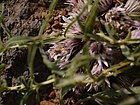Note: This is a project under development. The articles on this wiki are just being initiated and broadly incomplete. You can Help creating new pages.
Lepidagathis trinervis
Lepidagathis trinervis is a prostrate to suberect up to a foot tall. Twigs are quardrangular, bristly or hairless twigs, arising from a woody rootstock. Leaves are stalkless, linear to narrowly lanceshaped, 2-4.5 cm long, 3-5 mm broad, hairless, 3-nerved from the base, lateral nerves weaker than midrib and run along entire margin.
Contents
[hide]- 1 Uses
- 2 Parts Used
- 3 Chemical Composition
- 4 Common names
- 5 Properties
- 6 Habit
- 7 Identification
- 8 List of Ayurvedic medicine in which the herb is used
- 9 Where to get the saplings
- 10 Mode of Propagation
- 11 How to plant/cultivate
- 12 Commonly seen growing in areas
- 13 Photo Gallery
- 14 References
- 15 External Links
Uses
Bitter tonic, Rheumatic affections, Blotches, Swellings.
Parts Used
Chemical Composition
The hydro-distilled essential oil obtained from the flowering aerial parts of Lepidagathis fasciculata Nees was analyzed by gas chromatography equipped with a flame ionization detector (GC-FID) and gas chromatography coupled with mass spectrometry.[1]
Common names
| Language | Common name |
|---|---|
| Kannada | NA |
| Hindi | Musk Dana |
| Malayalam | Tran gha, Tran kantho |
| Tamil | NA |
| Telugu | NA |
| Marathi | NA |
| Gujarathi | Harancharo, Paneru |
| Punjabi | NA |
| Kashmiri | NA |
| Sanskrit | NA |
| English | Frilly Lepidagathis |
Properties
Reference: Dravya - Substance, Rasa - Taste, Guna - Qualities, Veerya - Potency, Vipaka - Post-digesion effect, Karma - Pharmacological activity, Prabhava - Therepeutics.
Dravya
Rasa
Guna
Veerya
Vipaka
Karma
Prabhava
Habit
Identification
Leaf
| Kind | Shape | Feature |
|---|---|---|
| Complex | Alternate | Sessile, muticose, acute, entire, lanceolate above, midrib beneath distinct, with a slender nerves parallel to it, near the margins, the margins scabrid, otherwise more or less glabrous. |
Flower
| Type | Size | Color and composition | Stamen | More information |
|---|---|---|---|---|
| Bisexual | 5 | White with yellow | Bracteate, bracts ovate, spinous-cuspidate-glabrous, often minutely pubescent at the apex and margin, bracteoles linear-lanceolate, softly membranous | Flowering from January to December |
Fruit
| Type | Size | Mass | Appearance | Seeds | More information |
|---|---|---|---|---|---|
| Caspsules ovoid-lanceolate | 2-seeded, yellowish-brown, shining, smooth seeds, brownish-black, rounded at the tip, with long mucilaginous hygroscopic hairs | Nil | Nil | Nil | Fruiting from January to December |
Other features
List of Ayurvedic medicine in which the herb is used
Where to get the saplings
Mode of Propagation
How to plant/cultivate
Easily grown in a rich well-drained soil in a sunny position.[4]
Season to grow
Soil type
Drained, Rich in nutrients.
Propagation
Commonly seen growing in areas
Photo Gallery
References
- Jump up ↑ Chemical constituents
- Jump up ↑ Morpholgy
- Jump up ↑ "Karnataka Medicinal Plants Volume - 2" by Dr.M. R. Gurudeva, Page No.286, Published by Divyachandra Prakashana, #45, Paapannana Tota, 1st Main road, Basaveshwara Nagara, Bengaluru.
- Jump up ↑ Cultivation details
External Links
- Pages using duplicate arguments in template calls
- Ayurvedic Herbs known to be helpful to treat Bitter tonic
- Ayurvedic Herbs known to be helpful to treat Rheumatic affections
- Ayurvedic Herbs known to be helpful to treat Blotches
- Ayurvedic Herbs known to be helpful to treat Swellings
- Herbs with Leaves used in medicine
- Herbs with Flowers used in medicine
- Herbs with Fruit used in medicine
- Herbs with common name in Hindi
- Herbs with common name in Malayalam
- Herbs with common name in Gujarathi
- Herbs with common name in English
- Habit - Suffruticose
- Index of Plants which can be propagated by Seeds
- Index of Plants which can be propagated by Cuttings
- Herbs that are commonly seen in the region of Indroda Park
- Herbs
- Malvaceae


